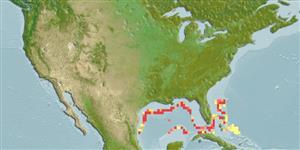Classification / Names
Common names | Synonyms | Catalog of Fishes(genus, species) | ITIS | CoL | WoRMS | Cloffa
Teleostei (teleosts) >
Ophidiiformes (Cusk eels) >
Ophidiidae (Cusk-eels) > Neobythitinae
Etymology: Monomitopus: Greek, monos = one + Greek, mitos, -ou = sting of a lyre + Greek, pous = foot (Ref. 45335).
More on authors: Carter & Cohen.
Environment: milieu / climate zone / depth range / distribution range
Ecology
Marine; bathydemersal; depth range 730 - 930 m (Ref. 34024). Deep-water; 5°C - 10°C (Ref. 31446); 30°N - 23°N
Western Atlantic: off eastern Florida, off northern Cuba, and in the eastern Gulf of Mexico off the Florida Keys.
Size / Weight / Age
Maturity: Lm ? range ? - ? cm
Max length : 53.5 cm SL male/unsexed; (Ref. 31446)
Uncommon species (Ref. 34024). Feed on euphausiid shrimps, gammarid amphipods, fish scales and a midwater myctophid (Ref. 31446). Feeding probably takes place on or just above the bottom, utilizing both benthic and benthopelagic crustaceans and fishes (Ref. 31446). Reproductive strategy possibly similar to other members of this family featuring oviparity, with oval pelagic eggs floating in a gelatinous mass (Ref. 205).
Life cycle and mating behavior
Maturity | Reproduction | Spawning | Eggs | Fecundity | Larvae
Nielsen, J.G., D.M. Cohen, D.F. Markle and C.R. Robins, 1999. Ophidiiform fishes of the world (Order Ophidiiformes). An annotated and illustrated catalogue of pearlfishes, cusk-eels, brotulas and other ophidiiform fishes known to date. FAO Fish. Synop. 125(18):178p. Rome: FAO. (Ref. 34024)
IUCN Red List Status (Ref. 130435: Version 2024-2)
Threat to humans
Harmless
Human uses
Fisheries: of no interest
Tools
Special reports
Download XML
Internet sources
Estimates based on models
Preferred temperature (Ref.
123201): 5.7 - 9.3, mean 8.8 °C (based on 8 cells).
Phylogenetic diversity index (Ref.
82804): PD
50 = 0.5001 [Uniqueness, from 0.5 = low to 2.0 = high].
Bayesian length-weight: a=0.00380 (0.00167 - 0.00864), b=3.14 (2.94 - 3.34), in cm total length, based on LWR estimates for this (Sub)family-body shape (Ref.
93245).
Trophic level (Ref.
69278): 3.8 ±0.62 se; based on food items.
Resilience (Ref.
120179): Medium, minimum population doubling time 1.4 - 4.4 years (Preliminary K or Fecundity.).
Fishing Vulnerability (Ref.
59153): Moderate to high vulnerability (46 of 100).
